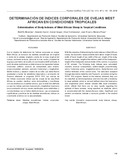Determinación de índices corporales de ovejas West African en condiciones tropicales
Fecha
2019Palabras Clave
Medidas zoométricas, Índices Corporales, Ovejas, West AfricanZoometric measurements, Body indexes, Sheep, West African
Metadatos
Mostrar el registro completo del ítemResumen
Con el objetivo de determinar los índices corporales en ovejas West African, se tomaron las medidas zoométricas de longitud y ancho de la cabeza, longitud y ancho de la oreja, longitud del cuerpo, perímetro torácico, altura de la cruz, ancho y longitud de la grupa y perímetro de la caña, en una muestra de 55 animales. A partir de estas mediciones se determinaron los siguientes índices corporales: cefálico, corporal, de compacidad, peso relativo, proporcionalidad, pelviano, pelviano transversal y longitudinal, dáctilo torácico, y espesor relativo de la caña. Los datos fueron analizados a través de estadística descriptiva y correlación de Pearson utilizando el programa SPSS 15.0. Los valores de los índices corporales indican que las ovejas de las raza West African se pueden clasificar como dolicocéfalas y brevilíneas con una tendencia a la aptitud cárnica, que no está bien definida ya que los índices pelviano transversal y longitudinal mostraron poca orientación cárnica, siendo clasificados como indefinidos, y corroborándose con el índice dáctilo-torácico. Las correlaciones significativas y positivas de las medidas zoométricas, indican un crecimiento armónico en la raza estudiada.
Colecciones
Información Adicional
| Otros Títulos | Determination of Body Indexes of West African Sheep in Tropical Conditions |
| Correo Electrónico | mymorantes@gmail.com ocolmena@mailcity.com rivasjoseh@gmail.com |
| Editor | SaberULA |
| ISSN | 0798-2259 |
| ISSN Electrónico | 2477-944X |
| Resumen en otro Idioma | The prediction of the digestible energy (DE) content of feeds (either single feedingstuffs or compound feeds) for horses from the chemical components of Weende analytical scheme (used for the labelling of compound feeds in several countries) has not been much studied. The objective of the present work was to develop an equation for the estimation of DE content of commercial compound feeds, using the values of the analytical components declared on the label as predictors. A total of 116 feedingstuffs of plant origin (cereal and legume grains, several by-products and dry forages) with known chemical composition were selected, and the digestible fractions were calculated from regression equations developed from several papers. The digestible organic matter obtained from the sum of the digestible components was in agreement with that calculated according to other authors. A general equation derived from the prediction equations of each of the digestible components and their respective heats of combustion was obtained to predict the DE content: DE (kcal/kg DM) = -236 + 48.5 x CP + 90.1 x EE - 6.7 x CF + 37.3 x NFE, where PB is crude protein, EE is ether extract, FB is crude fiber, ELN are nitrogen-free extractives and DM is dry matter. The DE values calculated after the application of this equation to the 116 feedingstuffs used in this study were not different (P > 0.05) to those obtained with the equations of other authors. In conclusion, the new equation could be used for the publication of tables of nutritional value of feeds for horses. It could also be useful for the fast and reliable calculation of the DE content of commercial compound feeds for horses. |
| Colación | 119-125 |
| País | Venezuela |
| Institución | Universidad del Zulia (LUZ) Universidad de Los Andes (ULA) |
| Publicación Electrónica | Revista Científica |






